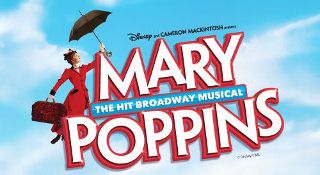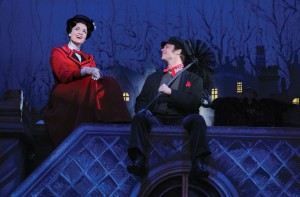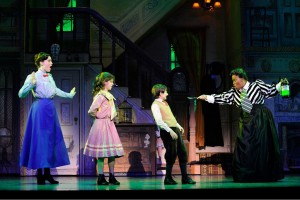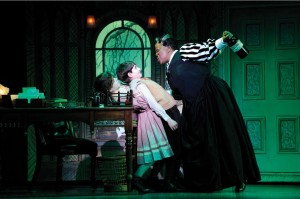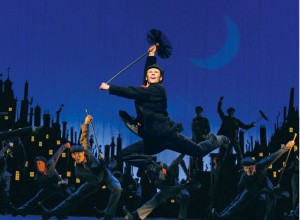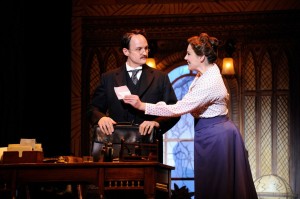PRACTICAL PERFECTION
There is a good-natured pragmatism at work in the stage musical version of the film classic Mary Poppins, now back in Los Angeles at the Ahmanson through September 2. It knows what we want it to be, and in almost every case, it gives it to us happily; with meticulous care and affection’”and for nearly three hours, an audience of children (some actual, some grateful for the chance to feel young temporarily) are enthralled’”even the toddlers and those of us in our Terrible Twos.
This is a lovely evening of theater, with everything and everyone operating at a gratifyingly consistent high level of professionalism. Yet there is also occasional magic on display, and to me, the most astonishing work is that of the father-son combo of Michael Dean Morgan and Zachary Mackiewicz as George and Michael Banks, respectively. Perhaps it is strange to single them out. Certainly Nicolas Dromard as Bert and Rachel Wallace as Mary Poppins are terrific. Almost fifty years after the release of the film, Britons still recall the inexorable Cockney accent of Dick Van Dyke as Bert with injured outrage (Van Dyke attributes his atrocious accent to his dialogue coach J. Pat O’Malley). Dromard treads lightly, with an accent only tinged by the East End. He is lithe and winning, and has a nice, if squeaky-clean, chemistry with Wallace, who gives Poppins expert and expressive vocal shadings, along with comic self-satisfaction that winningly doesn’t devolve into smugness.
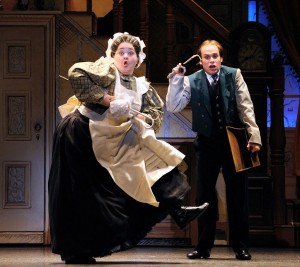 But for me, the Banks boys are the rather unsung glue that holds the whole enterprise together. Without their journey’”a flowering of self-discovery that leads to the dawning of true family connection’”there would be little heart to this co-production of theatrical behemoths Disney and Cameron Mackintosh.
But for me, the Banks boys are the rather unsung glue that holds the whole enterprise together. Without their journey’”a flowering of self-discovery that leads to the dawning of true family connection’”there would be little heart to this co-production of theatrical behemoths Disney and Cameron Mackintosh.
Yet Morgan makes it his own. He is precise and imaginative in his early supercilious disengagement, and touchingly flabbergasted when he finds himself cutting loose. His face and body virtually explode with the pleasure of feeling naughty and free. Morgan is helped along immeasurably by the plot tweaking in the stage musical that leads his character fully to the edge of destitution with greater seriousness and dread than does the film’”but the touching believability of little Mackiewicz is what allows the emotional resonance to fully flower. His longing for his daddy’s attention does not feel like the generic wish of a boy for a father, any father, but a specific need for this son to feel the love of this particular father.
He knows with all his heart that if his daddy would just teach him to fly a kite, then everything would be all right in their world.
The best musical moments are based in the familiar songs from the film: “Let’s Go Fly a Kite,” “Step in Time,” and “Supercalifragilisticexpialidocious.” The first of these three numbers is beautiful, its soaring music matched by its soaring kites and soaring hopes. The second is wildly exciting, complete with Bert literally walking upside down on the ceiling’”or more specifically the top of the proscenium. Particularly inspired is the last, which starts in a magical sweet shop in the park, and ends with a delirious, inventive appreciation of the alphabet. Led by Mary and Bert, as well as the addition of a dizzy Caribbean shop owner, played with enthusiastic brio by Tonya Thompson, the performers are almost drunk with glee at physically embodying the letters that make up the word. It also allows Mary Poppins to wiggle her chest and hips with an impish charm. Doubtless Julie Andrew, whose screen persona belied her fabled love of bawdiness, would approve.
 P.L. Travers, the author of the original Mary Poppins books, pronounced herself happy with the picture; “The whole picture is a splendid spectacle,” she wrote Walt; however, she would go on record as hating the film musical based on her work (Travers had been approached by Disney since the WWII years, but she always put up some kind of fight, demanding script approval and the non-singing Julie Harris for the lead). She resisted all further efforts of Disney to capitalize on the Poppins phenomenon with sequels, standing firm in her resolve until her death in 1996. When Cameron Mackintosh approached her for the stage rights in the early 90s, she struck a hard bargain. Mackintosh could use only English writers (specifically no Americans) and no one from the Disney film could be involved, including the Sherman brothers, who wrote the music for the film and were still very much alive and working at the time. However, original elements of the film could be incorporated.
P.L. Travers, the author of the original Mary Poppins books, pronounced herself happy with the picture; “The whole picture is a splendid spectacle,” she wrote Walt; however, she would go on record as hating the film musical based on her work (Travers had been approached by Disney since the WWII years, but she always put up some kind of fight, demanding script approval and the non-singing Julie Harris for the lead). She resisted all further efforts of Disney to capitalize on the Poppins phenomenon with sequels, standing firm in her resolve until her death in 1996. When Cameron Mackintosh approached her for the stage rights in the early 90s, she struck a hard bargain. Mackintosh could use only English writers (specifically no Americans) and no one from the Disney film could be involved, including the Sherman brothers, who wrote the music for the film and were still very much alive and working at the time. However, original elements of the film could be incorporated.
The creative team, led by the inestimable Julian Fellowes (currently collecting American awards for Downton Abbey and British ones for his new take on the Titanic disaster) did mostly terrific work expanding and cutting the material. The only thing I miss from the film is Mrs. Banks’ number “Sister Suffragette,” sung with great gusto by the late Glynis Johns, which is where I first encountered the idea of political inequality between the sexes. (That I can still recite its complicated lyrics several decades later says as much about my budding gay musical theater geek fascination with the stylish Ms. Johns than it does about my surprise at learning that some once believed women to be inferior to men’”a concept I still have trouble wrapping my head around.) New songs “Practically Perfect” and “Brimstone and Treacle” are wonderful, though I’m less inclined toward the second act closing number “Anything Can Happen,” an all-purpose appreciation of the heavens, the stars, and generalized belief in oneself. (Ironically, the melody for the film’s “Sister Suffragette” was taken from a song originally intended to introduce Mary to the children. It was to be called “Practically Perfect.”)
The new element in the stage version that Travers might well have appreciated most is a pronounced lurch toward her own conception of Mary Poppins as a frightening bitch rather than a sweet songbird. This is satisfyingly evident early on in “A Spoonful of Sugar,” when Poppins forces her medicine on Mrs. Banks, clearly terrifying the poor woman. (What is she offering up? Laudanum? Poison? Everyone who drinks it tastes his or her own favorite flavor. Mary’s is rum punch, so clearly the potion has intoxicating properties.) And later, when she teaches the children a lesson about their mistreatment of their toys, she brings the toys to life with sadistic efficiency, brutalizing Jane and Michael with the conceptually thrilling though lyrically uninteresting “Playing the Game,” before abandoning them.
The abandonment allows the introduction of Miss Andrew, Mr. Banks’ childhood nanny. Mrs. Banks tracks her down and brings her in as a surprise for her husband, who has always espoused Miss Andrew as the perfect nanny. In truth, he is still terrified of the old bat, with good reason. In “Brimstone and Treacle” she force-feeds the kiddies her own brand of medicine sans sugar, and threatens her own version of hell on Earth, before being banished to hell herself by the differently yet equally tyrannical Miss Poppins. The song is absolutely fabulous in its willingness to go there. As Miss Andrew, Q. Smith is spitefully up to the task, making a whole aria out of the word “rage.” She doubles as the delicate Bird Woman, showing us her softer side as she plaintively asks any and all to feed the birds for but tuppence a bag.
Bob Crowley gives us inventive scenic and costume designs that are all about transformation. The main set is a sort of pop-out doll house that turns and opens up to reveal the Banks household from different perspectives. It is inventive in a way that must be fascinating to children, who can spend the evening trying to figure out its tricks, from Mary Poppins turning a blanket into a hard bed, to the house seeming to turn itself inside out. The machinery isn’t visible exactly, but it’s apparent enough to be fascinating. The costumes are great, but seem like they must be something of a vexation for any actress who tackles the title role. She never stops changing her outerwear and accessories from one scene to another. Taking a coat off, putting another one on, changing gloves, adding an apron, taking it off, switching hats, making sure the red coat covers the blue skirt, that her top button is done in time to do her hand movements in a song transition’”it’s all kind of exhausting. Never mind that Rachel Wallace doesn’t break a sweat singing and dancing her way through twelve numbers’”she doesn’t break a nail fastening and unfastening what seems like hundreds of buttons.
It’s a lot to keep track of. No wonder she looks so happy at the end, when the audience cheers in delight as she flies out over the audience. For her the show is over, and she can take off that damned coat for the last time and put her feet up. She’s earned it. Rum punch anyone?
photos by Deen Van Meer
Mary Poppins
national tour at the Ahmanson Theatre
presented by Center Theatre Group
ends on September 2, 2012
for tickets, call 213.972.4400 visit CTG
for more info, visit Mary Poppins on Facebook
